The Ultimate Guide to Experiencing Dominican Culture in Punta Cana
Exploring Dominican Cuisine in Punta Cana
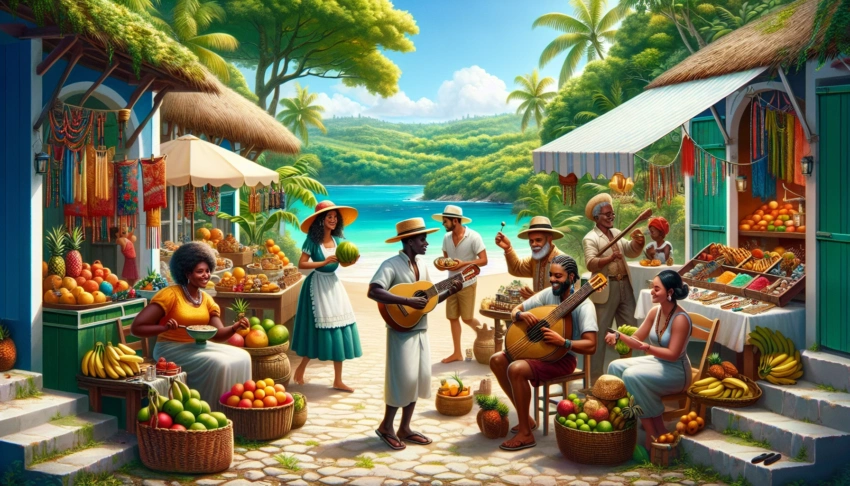
The Ultimate Guide to Experiencing Dominican Culture in Punta Cana
Embarking on a culinary journey through Punta Cana is an essential experience for any visitor looking to immerse themselves in the vibrant culture of the Dominican Republic. The island’s cuisine is a rich tapestry of flavors that reflects its diverse history and heritage.
1. Must-Try Traditional Dishes
Dominican cuisine is a delightful melting pot of influences, bringing together flavors from Taino, African, and Spanish culinary traditions. Exploring these dishes offers a window into the heart of the nation’s culture and history. Here are some iconic Dominican foods that you absolutely must try during your visit:
- Mofongo: A savory dish made from mashed plantains, often combined with garlic, pork cracklings, and a variety of fillings such as shrimp or chicken. This hearty meal is a staple in Dominican households and a testament to the island’s love for plantains.
- Sancocho: This traditional stew is an embodiment of Dominican warmth and hospitality. Made with a mix of meats, root vegetables, and spices, sancocho is often reserved for special occasions and family gatherings.
- Mangú: Typically served as a breakfast dish, mangú consists of mashed green plantains accompanied by eggs, cheese, and salami. Known for its comforting texture and taste, it’s a favorite way to start the day.
2. Local Drinks and Cocktails
The Dominican Republic is not only famous for its food but also for its refreshing and exotic beverages. Whether you’re unwinding by the beach or enjoying a local fiesta, these drinks are sure to elevate your culinary adventure:
- Mamajuana: Often referred to as the Dominican Republic’s national drink, mamajuana is a potent concoction made from rum, red wine, honey, and a mix of herbs and spices. It’s reputed to have health benefits and is a must-try for those seeking an authentic local experience.
- Presidente Beer: As the most popular beer in the Dominican Republic, Presidente is synonymous with relaxation and celebration. Its crisp and refreshing taste is perfect for the tropical climate of Punta Cana.
- Fresh Fruit Juices: With an abundance of tropical fruits, the Dominican Republic offers a variety of natural juices that are both delicious and rejuvenating. Try passion fruit, guava, or papaya juices for a taste of the island’s bounty.
3. Where to Eat Like a Local
To fully appreciate Dominican cuisine, it’s essential to dine where the locals do. Punta Cana offers a plethora of options, from quaint street food stalls to family-run eateries that serve up traditional dishes filled with love and flavor.
The vibrant culinary scene in Punta Cana is best experienced through its local restaurants and street food vendors. These hidden gems offer authentic flavors that are sure to leave a lasting impression on your taste buds.
- Comedor: These small, family-owned eateries are scattered throughout Punta Cana and provide an excellent opportunity to enjoy home-cooked Dominican meals at affordable prices. They are often bustling with locals, a testament to their authenticity.
- Street Food Stalls: For a quick and tasty snack, head to the street food vendors offering treats like empanadas, tostones, and chicharrón. These stalls are perfect for sampling a variety of flavors on the go.
- El Cortecito: Located in the heart of Bavaro, this area is known for its beachside restaurants that serve fresh seafood and traditional Dominican dishes. Enjoying a meal with an ocean view is an unforgettable experience.
Music and Dance: The Heartbeat of Dominican Culture
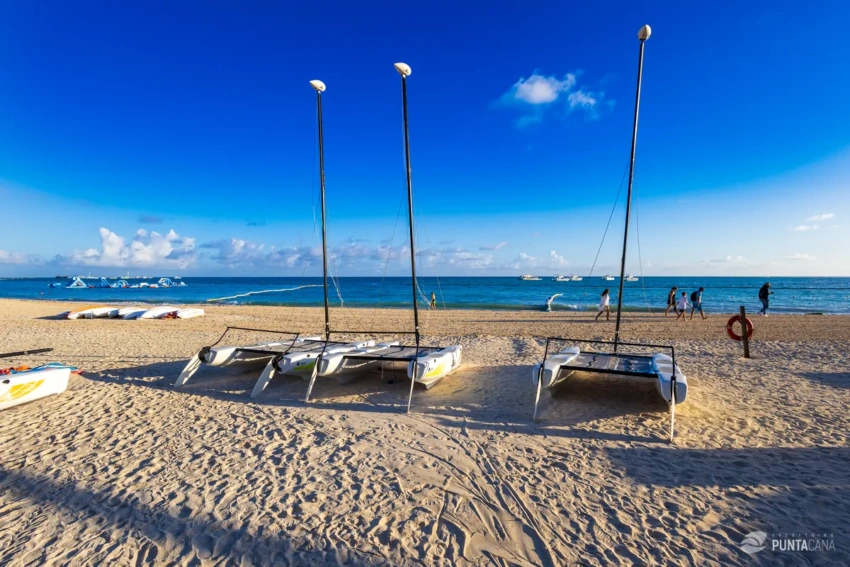
Punta Cana
Music and dance are not just art forms in the Dominican Republic; they are the very essence of the nation’s cultural identity. The vibrant rhythms and passionate movements encapsulate the spirit and soul of Dominican life, inviting locals and visitors alike to join in the celebration.
1. Merengue and Bachata
Merengue and Bachata are the heartbeat of Dominican music, each with a rich history and cultural significance that resonates deeply within the community. Merengue, declared a Masterpiece of the Oral and Intangible Heritage of Humanity by UNESCO, originated in the Dominican Republic in the mid-19th century. Characterized by its quick tempo and energetic beats, it is impossible to resist moving your feet to its rhythm. Merengue’s origins are reflected in its instruments, including the accordion, tambora, and güira, creating a sound that is uniquely Dominican.
Bachata, on the other hand, is a genre born in the rural settings of the Dominican Republic during the early 20th century. Known for its romantic and often melancholic lyrics, Bachata tells the stories of love, heartbreak, and everyday life. Its popularity skyrocketed globally in the late 20th century, with artists like Juan Luis Guerra and Romeo Santos bringing it to international stages.
2. Live Music Venues
Experiencing live music in Punta Cana offers an authentic taste of Dominican culture. From beachfront bars to sophisticated clubs, the city is dotted with venues that host both traditional and contemporary performances. Coco Bongo, renowned for its vibrant shows, combines elements of theater, disco, and live music into an unforgettable experience. Meanwhile, Imagine Punta Cana, set in a stunning natural cave, offers a unique atmosphere where you can enjoy local and international music.
For those seeking a more intimate setting, Jellyfish Beach Restaurant regularly features live bands playing everything from Merengue to Latin Jazz, providing a perfect backdrop for a night under the stars. The thriving live music scene in Punta Cana ensures there’s always a melody to match your mood.
3. Dance Lessons for Visitors
Embrace the opportunity to learn Dominican dances and bring a piece of this vibrant culture back home. Punta Cana offers numerous venues where visitors can take dance lessons, catering to all levels of experience. Bachata Rosa offers private and group classes where skilled instructors guide you through the steps of Merengue and Bachata, ensuring you feel confident on the dance floor.
Another excellent option is Punta Cana Salsa, where lessons often take place in outdoor settings, providing a fun and relaxed environment to learn. These classes are not just about learning dance moves; they offer insights into the cultural nuances and expressions that make Dominican dances so enchanting.
By immersing yourself in the rhythms and movements of Dominican music and dance, you gain a deeper understanding and appreciation for the country’s cultural heritage. Whether you’re a seasoned dancer or a curious newcomer, the experience promises to be both enlightening and exhilarating.
Festivals and Events in Punta Cana
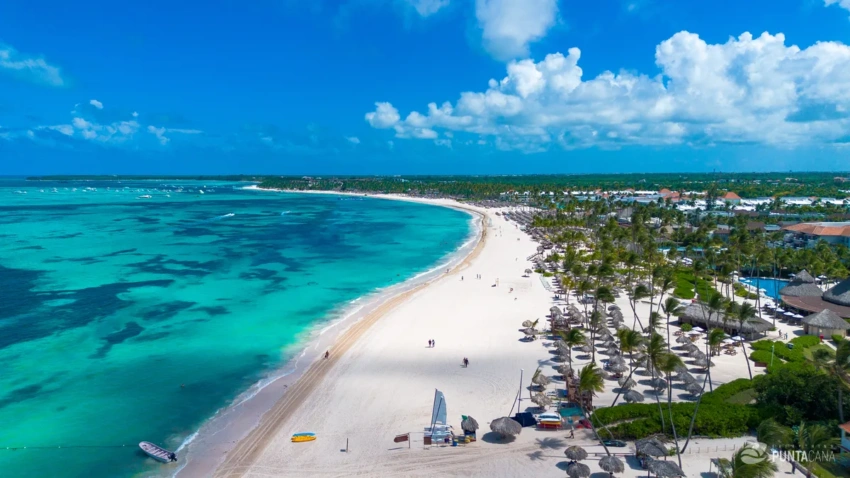
Punta Cana
Punta Cana is not just a paradise of sun and sand; it’s a vibrant hub of cultural festivities that offer a window into the heart of Dominican life. From the exuberant Carnival to intimate community gatherings, these events provide an immersive experience of local traditions and heritage.
1. Carnival and Other Major Festivals
The Dominican Carnival is an explosion of color, music, and dance, deeply rooted in the nation’s history. Taking place every February, Carnival is celebrated throughout the country, including Punta Cana, with a unique local twist. The event is characterized by flamboyant parades featuring vibrant costumes, lively music, and energetic dancing.
One of the highlights of this celebration is the “Diablos Cojuelos” or mischievous devils, who roam the streets in intricate masks and costumes, playfully interacting with the crowd. This tradition is a symbol of the country’s blend of African, European, and indigenous influences.
Beyond Carnival, Punta Cana hosts numerous other significant festivals. The Merengue Festival is another must-see, celebrating the national music and dance form with live performances and dance competitions. Additionally, the Guloya Festival, celebrated primarily in the nearby town of San Pedro de Macorís, showcases a unique blend of African and Caribbean cultural influences through vibrant dance and music.
Major Festivals in Punta Cana
| Festival | Date | Highlights |
|---|---|---|
| Carnival | February | Parades, costumes, “Diablos Cojuelos” |
| Merengue Festival | July | Live music, dance competitions |
| Guloya Festival | January | Traditional dance, music |
2. Local Art and Craft Fairs
For those interested in the artistic side of Dominican culture, Punta Cana offers numerous art and craft fairs that highlight the creativity of local artisans. These events are perfect for visitors looking to purchase unique souvenirs or gifts that embody the spirit of the Dominican Republic.
The Punta Cana Art & Craft Fair is one such event, where visitors can explore stalls brimming with hand-crafted jewelry, pottery, and paintings. Each piece often carries a story, reflecting the vibrant culture and history of the Dominican people.
Additionally, the Bavaro Artisanal Market offers a more rustic experience, where local artists and craftsmen display their wares. Here, you can find everything from traditional Dominican masks to vibrant paintings depicting local scenes.
3. Participating in Community Celebrations
Engaging with smaller community events is an excellent way to experience the warmth and hospitality of the local people. These celebrations, often less formal and more intimate than larger festivals, offer an authentic glimpse into Dominican life.
One such event is the “Fiesta Patronal”, a celebration held in honor of a town’s patron saint. These fiestas are characterized by religious ceremonies, traditional music, and dancing, providing a genuine community atmosphere.
Visitors are always welcome to join these celebrations, where they can enjoy local delicacies, participate in traditional dances, and even join in on community games. Engaging in these events not only enriches the travel experience but also fosters a deeper understanding and appreciation of the Dominican culture.
Whether you’re marveling at the vibrant costumes of Carnival or browsing the intricate crafts of local fairs, participating in Punta Cana’s festivals and events offers an enriching cultural experience that goes beyond the typical tourist itinerary. Embrace the opportunity to connect with the heart and soul of the Dominican Republic.
Exploring Punta Cana’s Cultural Landmarks
Punta Cana offers a vibrant tapestry of cultural landmarks that invite visitors to delve deep into the history and traditions of the Dominican Republic. These sites provide an enriching experience, allowing you to uncover the rich cultural heritage that shapes this beautiful nation.

Punta Cana
1. Indigenous Eyes Ecological Park
Nestled in the heart of Punta Cana, the Indigenous Eyes Ecological Park presents a fascinating journey into the area’s natural and cultural heritage. This ecological reserve spans over 1,500 acres and consists of a series of freshwater lagoons, which the Taíno people, the island’s original inhabitants, considered sacred.
Visitors can wander through the park’s lush surroundings, discovering the diverse flora and fauna that are native to the Dominican Republic. Each trail leads to one of the park’s twelve lagoons, five of which are open for swimming, offering a refreshing dip amidst nature. The park’s connection to Dominican culture is profound, as it not only highlights the natural beauty but also preserves the indigenous traditions and beliefs tied to the land.
For those interested in eco-tourism, this park is a must-visit. It provides educational tours that delve into the ecological importance and the traditional uses of the native plants by the Taíno people.
2. Historical Museums and Art Galleries
Punta Cana is home to several museums and art galleries that showcase the Dominican Republic’s vibrant history and dynamic art scene. These venues offer a window into the past, as well as the creative expressions that continue to evolve in the present.
One of the highlights is the ChocoMuseo, where visitors can learn about the history of cocoa in the Dominican Republic, a significant part of the nation’s agricultural heritage. The museum offers interactive tours and chocolate-making workshops, providing both educational and delectable experiences.
Art lovers should not miss the opportunity to visit local art galleries featuring works by Dominican artists. These galleries often host exhibitions that highlight the rich diversity of the Dominican art scene, from traditional crafts to contemporary pieces. Notable galleries include the Galería de Arte Contemporáneo, which frequently showcases pieces that reflect the island’s cultural narratives.
Comparing Punta Cana’s Museums and Galleries
| Museum/Gallery | Focus | Notable Features |
|---|---|---|
| ChocoMuseo | Cocoa history | Interactive workshops |
| Galería de Arte Contemporáneo | Contemporary art | Local artist exhibitions |
| Indigenous Eyes Museum | Ecology and history | Ecological significance |
3. Cultural Tours and Day Trips
To immerse yourself fully in the cultural tapestry of Punta Cana, consider embarking on a guided cultural tour or day trip. These excursions offer a deeper understanding of the Dominican Republic’s history, traditions, and way of life.
Several tours focus on the historical aspects of the region, such as visits to the nearby city of Higüey, where you can explore the Basilica of La Altagracia, a site of immense religious and cultural significance. Another popular tour takes visitors to the rural communities surrounding Punta Cana, offering a glimpse into traditional Dominican life.
For a taste of local culture, embark on a day trip to the vibrant city of Santo Domingo, the oldest continuously inhabited European settlement in the Americas. Here, you can explore the Colonial Zone, a UNESCO World Heritage site, and marvel at its historic architecture.
Our Best Cultural Tours in Punta Cana
Discover the most enriching cultural tours that Punta Cana has to offer. Whether you’re exploring the historic streets of Santo Domingo or the lush landscapes of the surrounding countryside, these tours promise an unforgettable journey into the heart of Dominican culture.
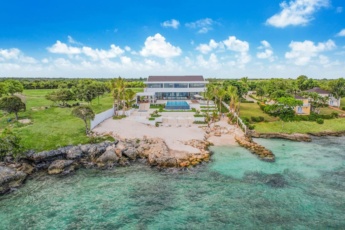
New & Luxury Casa de Campo Oceanfront Villa - With Private Beach, Large Pool, Top Amenities
from $14820 night Read more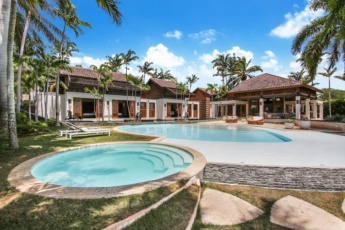
Casa de Campo Modern Villa for Rent - All-Inclusive Ocean View Villa with Chef, Butler & Maid
from $5616 night Read moreUnderstanding Dominican Traditions and Customs
Dominican culture is a vibrant tapestry woven from diverse influences, rich traditions, and a profound sense of community. To truly appreciate the essence of this Caribbean nation, one must delve into its traditions, social structures, and linguistic nuances.
1. Family and Social Life
At the heart of Dominican society lies the family unit, a cornerstone of social structure and cultural identity. The extended family often forms a close-knit community, where familial bonds are cherished and celebrated.
Dominican families prioritize togetherness and frequently gather for meals, celebrations, and religious events. These gatherings are not merely social but serve as vital opportunities to pass on traditions, stories, and values to younger generations. Such events are lively, filled with laughter, music, and the warm hospitality that Dominicans are renowned for.
Another key aspect of social life is the observance of fiestas patronales, local patron saint festivals that embody communal spirit and cultural pride. These festivities are marked by parades, music, dance, and traditional foods, reflecting the vibrant and celebratory nature of Dominican life.
2. Religious Practices and Their Influence
Religion plays a significant role in shaping the cultural landscape of the Dominican Republic, with Catholicism being deeply ingrained in both daily life and cultural practices.
The influence of Catholic traditions is evident in numerous aspects of Dominican culture, from the celebration of religious holidays like Easter and Christmas to the veneration of saints. The practice of attending mass and participating in religious events is common, with these occasions often serving as important social gatherings.
Beyond Catholicism, there is a rich tapestry of spiritual practices, including a blend of African and indigenous beliefs known as Santería and Vodou. These practices, though less visible, contribute to the country’s diverse cultural heritage and are respected components of the nation’s spiritual identity.
3. Local Language and Phrases
Language is a vibrant reflection of Dominican culture, with Spanish being the official language. However, the Dominican variant is distinctive, enriched by unique expressions and colloquialisms that offer insight into the local way of life.
Learning a few key phrases can greatly enhance your experience in the Dominican Republic. Common expressions such as “¡Qué lo qué!” (What’s up?) and “Dame luz” (Give me the scoop) are frequently used in casual conversations. Understanding these nuances not only aids communication but also fosters a deeper connection with the locals.
Common Dominican Phrases and Their Meanings
| Phrase | Translation | Meaning |
|---|---|---|
| ¡Qué chulo! | How cool! | Used to express approval or admiration. |
| ¡Bacanísimo! | Awesome! | Highly positive expression of something impressive. |
| ¡No bulto! | No kidding! | Affirms the truth or reality of a statement. |
The Dominican dialect is characterized by its rapid pace, omission of certain sounds, and a melodic intonation that reflects the country’s vibrant culture. Embracing these linguistic elements rather than just understanding them allows visitors to immerse themselves fully in the Dominican way of life.
Frequently Asked Questions
What are some must-try Dominican dishes in Punta Cana?
When in Punta Cana, be sure to try Sancocho, a hearty stew made with meats and root vegetables. Another favorite is Mangu, mashed plantains typically served with eggs and salami for breakfast. Don’t miss out on La Bandera, the national dish consisting of rice, beans, and meat. For seafood lovers, Pescado con Coco (fish in coconut sauce) is a delicious choice.
What cultural events can I experience in Punta Cana?
Punta Cana offers a variety of cultural events. The Carnival in February is a vibrant celebration featuring parades and traditional music. Throughout the year, you can also enjoy Dominican music festivals showcasing merengue and bachata. Check local listings for art exhibitions and dance performances to experience the local arts scene.
How can I experience Dominican music in Punta Cana?
To experience Dominican music, visit local clubs or bars where they play live merengue and bachata. Many resorts offer themed nights with traditional music and dance performances. You can also attend a local festival or seek out a concert featuring popular Dominican artists.
Are there any traditional Dominican crafts to look for in Punta Cana?
Yes, when visiting Punta Cana, look for traditional crafts such as Larimar jewelry, unique to the Dominican Republic. Amber jewelry is also popular. Additionally, you can find Taino art and crafts, showcasing the heritage of the island’s indigenous people. Handmade ceramics and woven items make for great souvenirs.
What language is primarily spoken in Punta Cana, and will I need to know Spanish?
The primary language spoken in Punta Cana is Spanish. However, English is widely spoken in tourist areas, so you should have no trouble communicating. Learning a few basic Spanish phrases can enhance your experience and show respect for the local culture.
What are some popular Dominican drinks to try?
While in Punta Cana, try the traditional drink Mamajuana, a unique blend of rum, red wine, and honey soaked with tree bark and herbs. Presidente beer is a local favorite, and Rum is widely enjoyed in cocktails or neat. Tropical juices and coconut water are also refreshing options.
How can I respectfully experience Dominican culture in Punta Cana?
To respectfully experience Dominican culture, engage with locals, learn about their customs, and participate in cultural events. Support local artisans by purchasing handmade crafts and try to learn some Spanish to communicate better. Always be open-minded and respectful towards cultural differences.
What traditional attire might I see in Punta Cana?
In Punta Cana, traditional attire may be observed during cultural events and performances. Women might wear flowing dresses with bright colors and ruffles, while men might wear guayabera shirts, a traditional button-up shirt. These garments are often worn for folk dances and celebrations.
